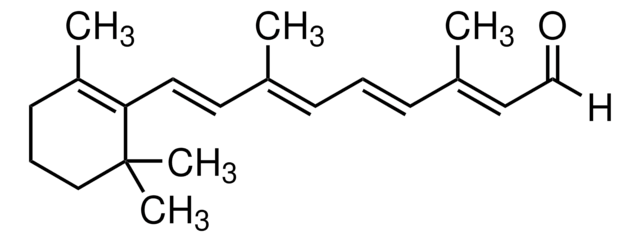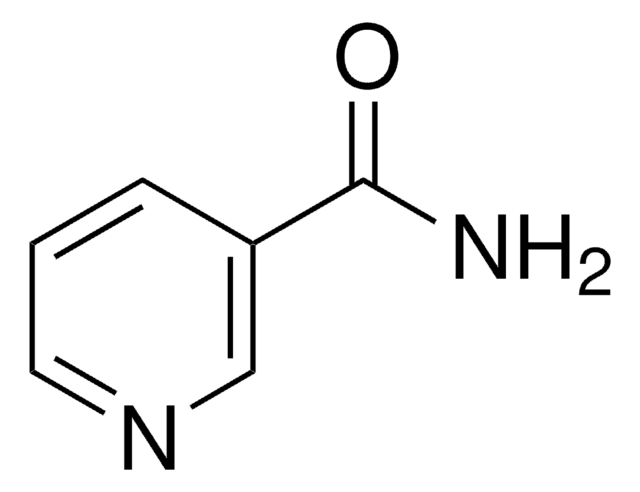B6688
BMS 493
≥98% (HPLC)
Synonym(e):
(E)-4-[2-[5,6-Dihydro-5,5-dimethyl-8-(2-phenylethynyl)naphthalen-2-yl]ethen-1-yl]benzoic acid, 4-[(1E)-2-[5,6-Dihydro-5,5-dimethyl-8-(phenylethynyl)-2-naphthalenyl]ethenyl]-benzoic acid, BMS204, 493
About This Item
Empfohlene Produkte
Qualitätsniveau
Assay
≥98% (HPLC)
Form
powder
Farbe
light yellow to yellow
Löslichkeit
DMSO: ≥20 mg/mL
Ersteller
Bristol-Myers Squibb
Lagertemp.
2-8°C
SMILES String
CC1(C)CC=C(C#Cc2ccccc2)c3cc(\C=C\c4ccc(cc4)C(O)=O)ccc13
InChI
1S/C29H24O2/c1-29(2)19-18-24(14-10-21-6-4-3-5-7-21)26-20-23(13-17-27(26)29)9-8-22-11-15-25(16-12-22)28(30)31/h3-9,11-13,15-18,20H,19H2,1-2H3,(H,30,31)/b9-8+
InChIKey
YCADIXLLWMXYKW-CMDGGOBGSA-N
Allgemeine Beschreibung
Anwendung
- as an inhibitor for the dietary and pharmacologic manipulation of retinoic acid (RA) activity in vivo and in vitro
- for human induced pluripotent stem cells (iPSCs) culture and ventricular cardiomyocytes (VCMs) differentiation
- to inhibit retinoic acid (RA) signaling in explants
- as a retinoic acid receptor (RAR) inhibitor for the induction of synaptonemal complex protein 3 (SCP3) and ATP-dependent RNA helicase (DDX4) in primordial germ cells (PGCs)
Biochem./physiol. Wirkung
Leistungsmerkmale und Vorteile
Lagerklassenschlüssel
11 - Combustible Solids
WGK
WGK 2
Flammpunkt (°F)
Not applicable
Flammpunkt (°C)
Not applicable
Analysenzertifikate (COA)
Suchen Sie nach Analysenzertifikate (COA), indem Sie die Lot-/Chargennummer des Produkts eingeben. Lot- und Chargennummern sind auf dem Produktetikett hinter den Wörtern ‘Lot’ oder ‘Batch’ (Lot oder Charge) zu finden.
Besitzen Sie dieses Produkt bereits?
In der Dokumentenbibliothek finden Sie die Dokumentation zu den Produkten, die Sie kürzlich erworben haben.
Kunden haben sich ebenfalls angesehen
Artikel
We offer many products related to non-steroid nuclear receptors for your research needs.
Verwandter Inhalt
Apoptosis, or programmed cell death (PCD), is a selective process for the removal of unnecessary, infected or transformed cells in various biological systems. As it plays a role in the homeostasis of multicellular organisms, apoptosis is tightly regulated through two principal pathways by a number of regulatory and effector molecules.
n proliferating cells, the cell cycle consists of four phases. Gap 1 (G1) is the interval between mitosis and DNA replication that is characterized by cell growth. Replication of DNA occurs during the synthesis (S) phase, which is followed by a second gap phase (G2) during which growth and preparation for cell division occurs. Together, these three stages comprise the interphase phase of the cell cycle. Interphase is followed by the mitotic (M) phase.
Unser Team von Wissenschaftlern verfügt über Erfahrung in allen Forschungsbereichen einschließlich Life Science, Materialwissenschaften, chemischer Synthese, Chromatographie, Analytik und vielen mehr..
Setzen Sie sich mit dem technischen Dienst in Verbindung.






